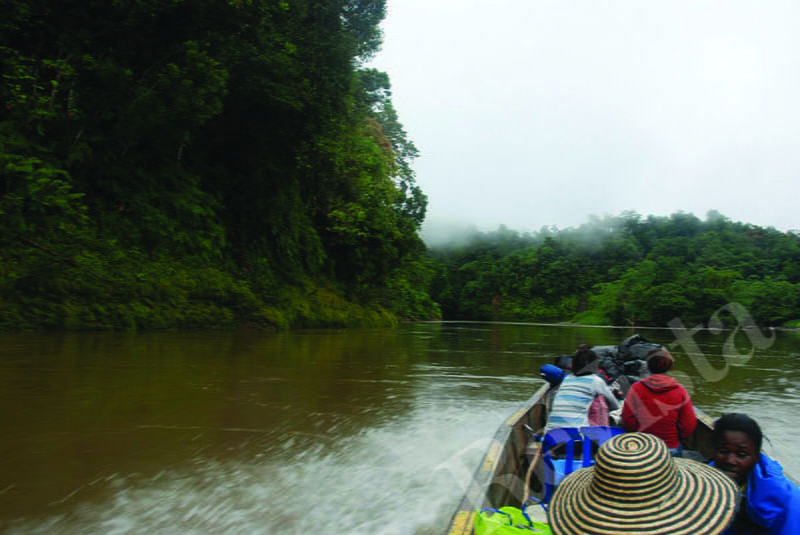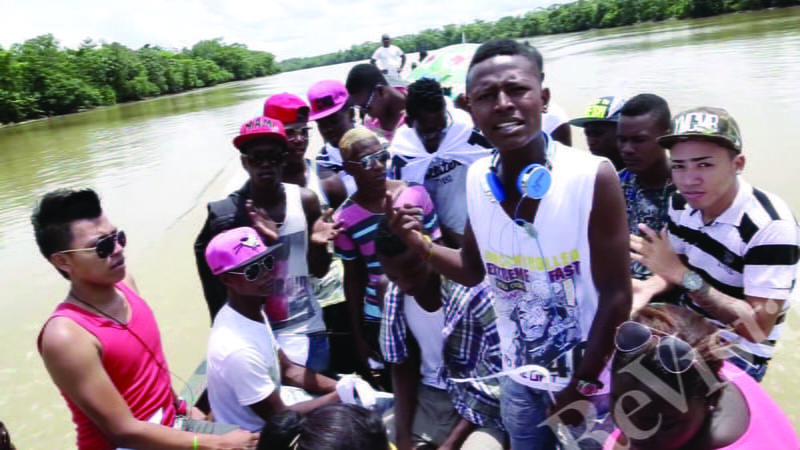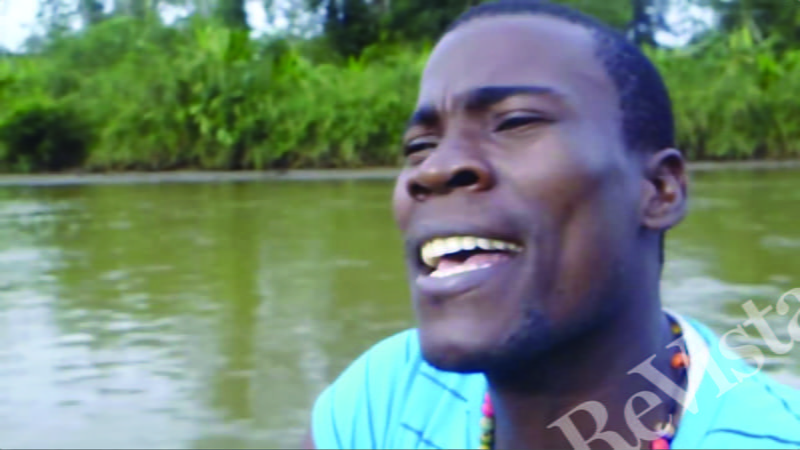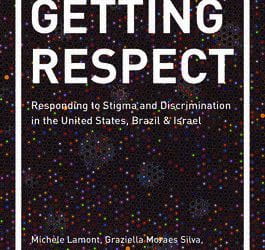Voices from the Atrato River
A traditional panga boat with thirty passengers cruises the mighty waters of the Atrato River in the Pacific region of Colombia, doing a 142-mile route from Quibdó to Bojayá. In the stern of the boat, adult women and men protect themselves from the sun with big colorful umbrellas. Meanwhile, up front, a group of teenagers form a semicircle. Clapping, they make a beat for an improvised rap. One of the boys, standing in the middle, sings a politically conscious rhyme:
No más violencia en el Chocó
aquí vivo yo
y yo sueño con esta tierra
algún día poderla progresar
y decir la verdad
No more violence in the Chocó
here I live
and I dream with this land
someday it will improve
and tell the truth .
The Colombian department (state) of Chocó lies between the Andes mountain chain and the Pacific Ocean, with Panama on its northern border. Ignored for centuries by the government in Bogotá and rendered invisible by the mainstream media, the Chocó has become in the past two decades one of the main battlefields of an intense armed conflict. Paramilitaries and criminal groups, along with the the Colombian army and FARC and ELN guerrillas, have all engaged in bloody confrontations in this territory. A strategic location, with many rivers, Chocó serves as a corridor between the Atlantic and the Pacific oceans. Illegal groups use this territory for trafficking drugs and arms, extracting natural resources such as gold and platinum, and cultivating coca crops. The local population, composed mostly of Afro-Colombians (87%), has been affected by these incursions, suffering massacres, forced army recruitment, routine violence and displacement. Between 1985 and 2013, 279,507 people, almost half the population of the Chocó was internally displaced, creating a humanitarian crisis of massive proportions (Departamento de Prosperidad Social, 2013).
The Afro-Colombian youth, who were rapping on that panga boat, are recorded in one of the videos published online by Memorias del Rio Atrato , a digital media project developed by local Chocoano communities with the support of Alfabetizaciones Digitales, an initiative from the Centro Nacional de Memoria Histórica in Colombia. Lucely Rivas Espinoza, a member of the project, created the video in 2014 using her mobile phone while she was participating in Atratiando, a non-violent protest commemorating the massacre of Bellavista, Bojayá. The mass violence occurred on May 2, 2002, during a combat between FARC guerrillas and paramilitaries. A cylinder-bomb shot by the guerrillas exploded in a church sheltering adults and children, killing 119 civilians. After the massacre, more than 6,000 peasants from the mid-Atrato region abandoned their land to avoid the multiple forms of violence generated by the armed groups. Like the Afro-Colombian youth who sing in the video, many of the internally displaced persons from this region migrated to Quibdó, the capital of Chocó and the major urban center for the Chocoano internal diaspora.
AN EMERGING FORM OF CITIZEN MEDIA: THE PROJECT MEMORIAS DEL RIO ATRATO
Eight grassroots social organizations and community councils (Consejos Comunitarios) from the mid-Atrato region have collaborated in Memorias del Rio Atrato since the project started in 2013. Members of these organizations use digital media, particularly mobile phones with multimedia recording capabilities, to producie and circulate their own stories of resistance to violence, and their own creative expressions among wider audiences. “We want to show that our territory has been violated and attacked in all its aspects,” Rivas told me. She added, “we want to show that our people have suffered and resisted to violence, as well as that we can live in a different and peaceful way.”
Rivas, a 33-year-old Afro-Colombian woman who migrated to Quibdó as a teenager after being displaced from Buchadó, has worked with COCOMACIA (Consejo Comunitario Mayor de la Asociación Campesina Integral del Atrato) for eight years. She works at the community radio station, and documents the activities of the organization while she travels across the mid-Atrato region attending meetings and events. As a member of COCOMACIA, Lucely actively participates in the Memorias del Rio Atrato project, and has become one of the main administrators of the website, and a prolific videographer. She has participated in several workshops developed by Alfabetizaciones Digitales, received training in digital storytelling, and become a “virtual manager of memory.” That is, she is a producer of multimedia stories for the web and a contributor to the process of memory making.
The project Memorias del Rio Atrato is an emerging form of citizen media. According to communication scholar Clemencia Rodríguez, citizen media empowers citizens to name the world in their own terms and allows them to articulate identities that are connected to local cultures and achievable utopias (Fissures in the Mediascape, 2001). The multiplicity of stories that members of Memorias del Río Atrato have told from their own perspective, using their own voices, provide an account of how displaced persons can use digital media to name their world, its problems, and hopes, and speak back to the center. The creation and circulation of these media texts is allowing displaced Chocoano communities to elaborate narratives about their territories and lived experiences, and to contribute to the making of memory of the Colombian armed conflict.
Although lack of access to the Internet and electricity has limited the participation of many members of the mid-Atrato rural communities, youths and adults from the areas that have connectivity (Quibdó, Vigía del Fuerte, Bellavista) have been able to engage in the project. They have leveraged the digital tools they have at hand, and used them to tell stories. By producing photographs, texts, audios, and videos, and publishing them online on the community website, they have been able to create a space where marginalized Chocoano voices and identities become visible and heard.

Members of the Project Memorias de Río Atrato travel along the river in a traditional panga boat, singing and improvising rap music to express their identity as displaced people from the Chocó region. The project is an emerging form of digital citizen media. Photo by Lucely Rivas Espinoza http://www.memoriasdelatrato.org/
The audiovisual record of the rap performance on the Atrato river, for instance, shows how displaced Afro-Colombian youth act a collective Chocoano identity through hip hop culture, and are able to explicitly talk about their utopia of ending the war and about the political issues of their region. Surrounded by the tropical forest, cruising one of the wide serpentine curves of the river, and without any signs of modern civilization, we listen to the rising youth voices:
Vamos a la paz
y que se acabe la guerra
no quiero mas muertes
pa la gente de mi tierra
Let’s have peace
and end the war
I do not want more death
for the people of my land.
Other media texts published on Memorias del Rio Atrato have a more personal point of view and tell a more subjective experience. That is the case of “De mi Tierra No Me Quiero Ir” (“From My Land I Do Not Want to Go”), a video of a song that Lucely recorded on the river Munguidó, one of the 150 tributaries of the Atrato. In the video, Jhonier Palacios Paneso, an Afro-Colombian youth displaced from the town of Tagachí, sings one of his compositions. The song narrates the drama of Jhonier’s father, a peasant who abandoned his land in the countryside and moved to the city escaping the armed violence.
Y si va por la calle le dicen: “allá va el desplazao”,
Y él no es culpable de todo lo que ha pasao,
Si amor y su vida al campo se lo ha dedicao.
And when he strolls the street they say: “there goes the displaced”
And he is not guilty of everything that happened to him
With love and life he has dedicated himself to the land.
Jhonier’s interpretation is full of emotion and reveals the resilience of displaced persons able to overcome violence. Following the rhythm of a chirimia, a popular Chocoano music genre, the song combines the nostalgia for peasant life with the feelings of a displaced person now in the city. After evoking local food such as bocachico, borojó and chontaduro, in the chorus lines Jhonier articulates the desire of displaced persons to stay in their native land.
De mi tierra no me quiero ir,
De mi campo no me quiero ir,
Yo de mi campo no me quiero ir.
From my land I do not want to go
From my country I do not want to go
I, from my land, do not want to go.
MAKING MEMORY, BUILDING PEACE
The project Memorias del Rio Atrato has opened a communication space where internally displaced persons from the mid-Atrato region in central Chocó can speak up and become visible to national and global audiences. Because this population, like other victims of war in Colombia, has been made invisible by mainstream narratives of the armed conflict, the media texts created and published by Memorias del Río Atrato are significant contributions to the construction of historical memory and to the collective understanding of the experience of displacement. “I think the website and the content we publish makes memory. We have made memory with our videos and stories,” said Lucely, while reflecting on the impact of the project.
In a country where internally forced displacement reached the shocking number of 6,360,000 persons in 2014 (Internal Displacement Monitoring Centre) and where the humanitarian crisis has not been fully addressed by society or the state, these kinds of citizen media projects have the potential to promote sociocultural understanding and change. Making the narratives of the Chocoano internal diaspora visible can help to raise awareness, create empathy toward the victims of war, rebuild the social fabric, and, ultimately, contribute to building peace.
Winter 2017, Volume XVI, Number 2
Andrés Lombana-Bermudez is a Colombian post-doctoral fellow at the Berkman Klein Center for Internet and Society and a research associate with the Connected Learning Research Network.
Related Articles
Colombia’s Other Displacements
Of course, I knew about Colombia’s sad statistics on displacement, with the highest numbers in Latin America and vying with those of war-torn countries like Sudan and…
Getting Respect
When I first arrived in Brazil in the 1980s, I quickly learned that race in Brazil was not important there. The country that once had by far the largest slave population in the…
Ana Tijoux’s Radical Crossing of Borders
This summer, I was an intern in Santiago’s Museum of Memory and Human Rights, the museum dedicated to the victims of Pinochet’s dictatorship. Since I was in Chile…







